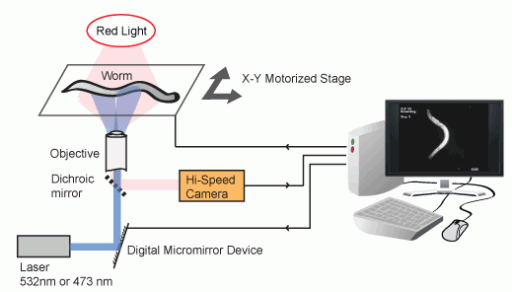An optogenetic technique for neuroscience that uses lasers to manipulate neurocircuits in moving animals
January 17, 2011
Researchers at Harvard University’s Center For Brain Science have developed a new technique for neuroscience called CoLBeRT* (control locomotion and behavior in real time) that allows researchers to commandeer the nervous system of a moving animal without wires or electrodes. The system has been used thus far on the microscopic nematode C. elegans.
Scientists are using CoLBeRT to understand how a handful of neurons can work together in an animal to generate behavior. The nematode C. elegans is an ideal organism to study because it has only 302 neurons and it is easy to modify genetically. By comparison, a human being has roughly 100 billion neurons.
The CoLBeRT system uses nematodes that express an extra gene for a light-sensitive ion channel protein, such as Channelrhodopsin or Halorhodopsin. This extra protein is similar to the protein in a human’s eye. When added to the worm’s neurons, these proteins makes the worm’s neurons sensitive to different colors of light. The CoLBeRT system tracks the worm as it moves and shines laser light on specific neurons as the worm is moving to stimulate or inhibit those neurons.
More videos of the CoLBeRT system are available here.
In this way the worm can be induced to paralyze, lay eggs, back up, speed up or sense touch in different areas of its body. The Samuel Lab is using this tool to study different neurocircuits in the worm. All of the associated software and source code for the CoLBeRT system is free to download.
Ref.: Optogenetic manipulation of neural activity in freely moving Caenorhabditis elegans, Nature Methods
Adapted from materials provided by Harvard University
* “The CoLBeRT project is dedicated to its namesake, Stephen Colbert, who manipulates the neurocircuits of millions of Americans daily using only the light from their monitors.” — Harvard University Center For Brain Science
